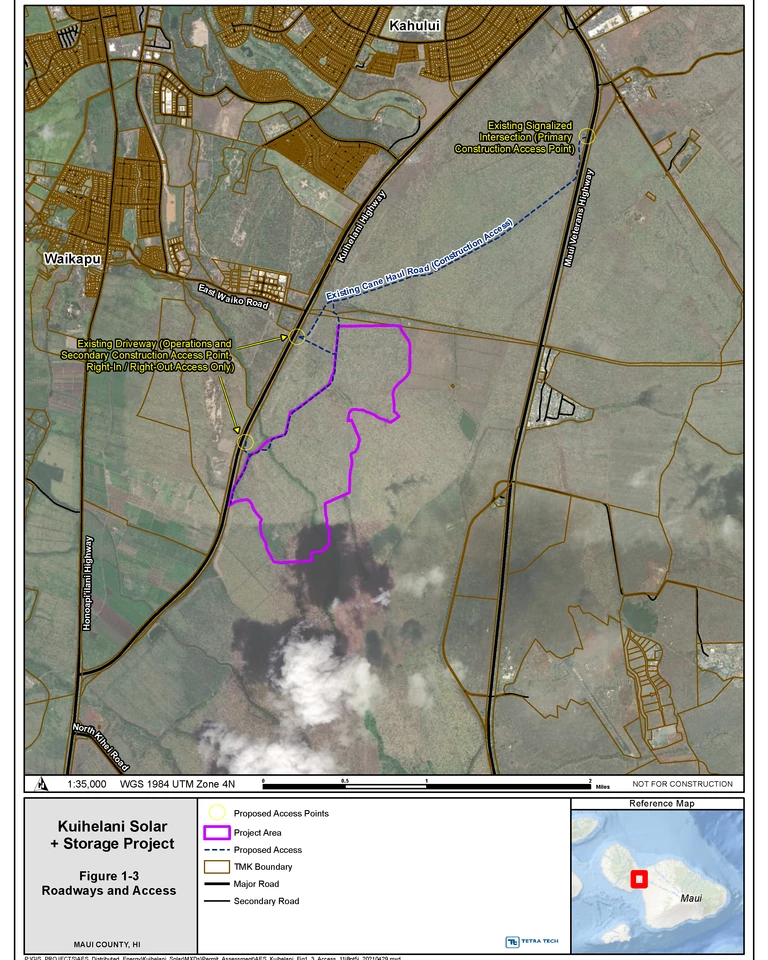Project contact information
If you have any questions or concerns please reach out to our Community Outreach Representative.
Community Outreach Representative: Carrice Gardner
Email: KuihelaniSolar@aes.com
Project Hotline: +1 (808) 800-3942
Regulatory approvals and community outreach
November 9, 2021 – Presentation to Maui Planning Commission
Agenda with links to documents
Minutes with links to audio recordings
May, 2021 – Maui County Special Use Permit Application File no. CUP 2021/0003
Application, Exhibits and Findings of Fact, Conclusions of Law and Decision and Order
September 14, 2020 - Presentation to Waikapū Community Association
June 17, 2020 – Update to Maui Lāna‘i Island Burial Council
Audio recording of presentation
October 16, 2019 – Update to Maui Lāna‘i Island Burial Council
May 15, 2019 – Presentation to Maui Lāna‘i Island Burial Council
November 15, 2018 – Early-stage public community meeting
Public Utilities Commission
Kūihelani Solar + Storage
- 60 MWac solar photovoltaic
- 240 MWh containerized lithium-ion battery energy storage
- Feeds into Maui utility (HECO) electrical grid
- Located in Central Maui, off Kūihelani Highway
- Utilizes approximately 450 acres of land leased from Mahi Pono
- 25-year Power Purchase Agreement (PPA)
- Decommissioning and return of Project area to its existing condition (or comparable) at end of the lifespan
Project details
Collaboration and engagement
AES Hawaiʻi is deeply committed to being an active, invested member of the communities we serve.
Community Input
Throughout the process, AES Hawaiʻi has and will continue to engage and listen carefully to community feedback on the Project. Specific issues identified by the community thus far are actively being addressed and we continue to seek input to ensure we are responsibly examining concerns.
Culture and archaeology
AES Hawaiʻi recognizes we have a responsibility to respectfully address the issues and perspectives of the Native Hawaiian community early in the process. With this understanding, we started the Project by undertaking the following actions:
-
Consultation with Lineal and Cultural Descendants – One of the earliest outreach efforts we undertook was consultation with lineal and cultural descendants and the Maui Lanai Islands Burial Council to identify issues and concerns, especially those related to iwi kupuna.
-
Ground Penetrating Radar (GPR) – In consultation with descendants and the Burial Council, the Kūihelani Solar + Storage Project is one of Maui’s first projects to utilize Ground Penetrating Radar (GPR) to identify subsurface anomalies.
-
Archaeological Inventory Survey (AIS) and Cultural Impact Assessment (CIA) – An AIS and CIA have been conducted in consultation with descendants and the State Historic Preservation Division. A preliminary report has been presented to the Maui Lāna‘i Islands Burial Council and an archaeological monitoring plan (AMP) which outlines the plan for on-site monitoring during excavation and other ground-disturbing activities during construction to ensure archaeological resources are protected during the development of the Project has been reviewed and accepted by the State Historic Preservation Division (SHPD).
Traffic
AES Hawaiʻi is committed to minimizing our impacts on Maui commuters.
-
Minimal Operational Vehicles and Traffic – Upon completion, only 2-4 vehicles per day will be required to operate and maintain the Project.
-
Construction Traffic Management Plan – During the construction phase, a traffic management plan will be implemented to minimize traffic impacts.
-
Traffic Impact Analysis Report (TIAR) – A full Traffic Impact Analysis Report (TIAR) is being developed for the Project. The analysis concluded that the construction of the Project will not adversely impact the traffic in the area.
Fire and safety
Brushfires are a significant community concern and AES Hawaiʻi takes this issue very seriously.
-
Fire Suppression – Each battery storage container is equipped with a fire suppression system that will minimize the risk of fire from Project components.
-
Firebreaks – A non-vegetated firebreak will encircle the Project area as well as each battery storage area to further reduce fire risk.
-
Vegetation Management – AES Hawaiʻi will actively maintain the vegetation on-site to minimize the risk of brushfires spreading through the property.
Visual impacts and project footprint
Community members have raised visual impacts and minimizing the land utilized as important considerations.
-
Reduction in Project footprint – AES Hawaiʻi takes community input seriously, and in response to feedback received, was able to reduce the overall project footprint by approximately 35% compared to the original site layout. The use of the newest, most efficient technology has enabled the reduction of the project area and an increased distance from residences in nearby communities and Kūihelani Highway.

-
Sensitive Siting – As much as possible, the Project has been designed and laid out to reduce visual impacts, especially along Kūihelani Highway and Maui Veterans Highway.
-
Landscaping – Where practicable, landscaping will be incorporated to further reduce visual impacts.
-
Visual Simulations and View Planes – To better understand the visual impacts and to assist with refinement of the location of project components in order to minimize the impacts to commuters and residents, AES has prepared renderings to simulate views of the project from various vantage points.
-
Glare – A glare analysis has been conducted from key observation points to minimize and mitigate impacts to commuters, residents, and air traffic. The analysis concluded the project will not produce glint or glare to commuters, air traffic, or nearby communities.
Agricultural use
Community feedback indicated agriculture was a priority, along with clean energy.
-
Avoiding highly productive soil – the Project has been designed to avoid the most productive agricultural soil and is sited on LSB Class E soils.
-
Compatible use – AES Hawaiʻi would make the land within the Project area available at no cost for compatible agricultural activities such as rotational sheep grazing and local honey production which would promote natural vegetation management and contribute to Maui's local food production.














